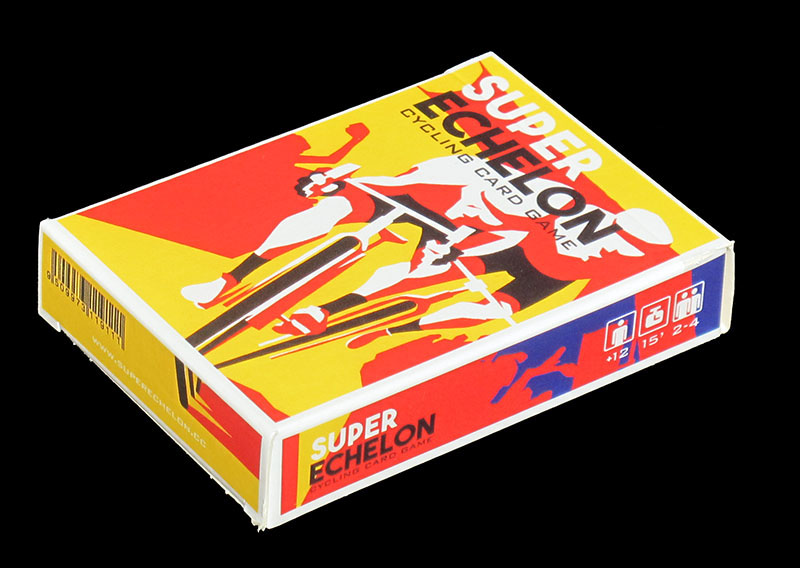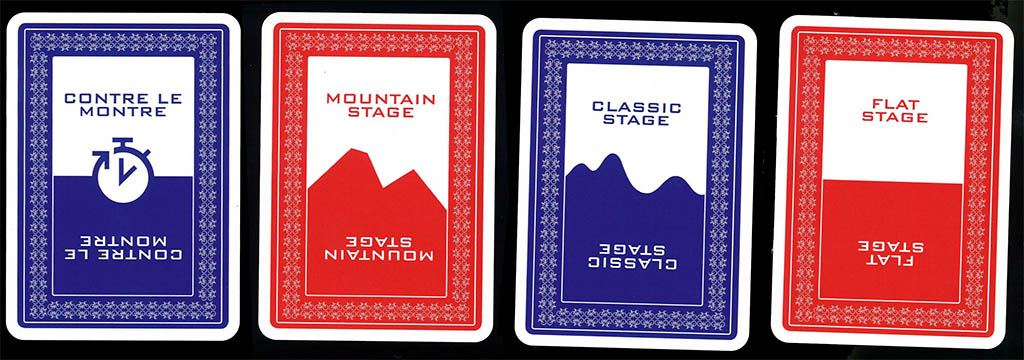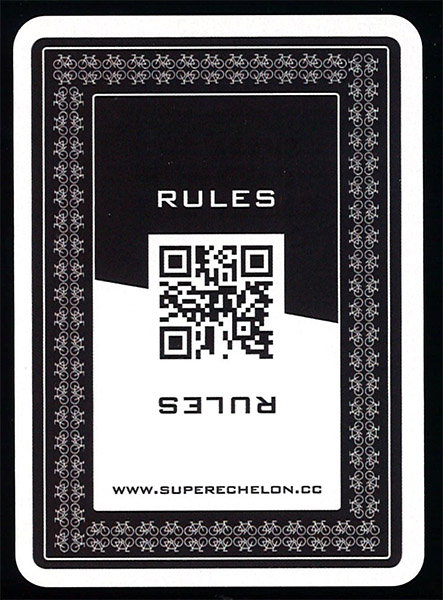
SUPER
ECHELON
Alex Bardají, Spain, 2023

Super Echelon is a quite unusual cycling game. Of course, it is not a race game according to the classic definition. It is a card game that represents a cycling race, but this is not unheard of these days. However, there is a certain something in the game mechanics that makes it unusual, and also quite interesting.
First of all, I am not really sure if this is one game or two. While the box states that this is a game for two to four players, the rules (not included, see below) point otherwise. Besides, four players is not the upper limit. More can take part in the game, though you will need a second deck. If I were you, I would buy two decks. If you do not use the second one after a while, it will always make a nice present for Christmas.
Furthermore, the rules for a two-player game are different enough (though of course they have much in common) from the multiple-player rules that I would rather consider it a different game. For instance, in the two-player game there are no echelons (which is, after all, the title of the game). Anyway, it is up to you to decide whether they are two different games.

I will not comment the rules in depth, since they are public and you can read them by yourselves. But let me say that the deck consists of 48 nicely illustrated cards (they have a Russian constructivist look, don't they?)

We find seven types of riders, plus two circumstances (good day / bad day). There are four cards for each type of rider except gregarios and super gregarios, of which there twelve and eight, respectively. Each card has a GC value (top left corner, in red) and four stage values (in black, under the illustration), which apply according to the type of stage.

The type of stage is determined by the back of the upper card of the deck (the last stage, when there aren't any cards left in the deck, is always a flat stage, let's say the Champs Elysées). Blue cards have the bluer (winter?) illustrations on the other side, and red cards have the yellowish (summer?) illustrations. However, these colors are just design features to make the game nicer, with no influence on the actual play.
By the way, there is a typo in the time trial card, it should be "contre LA montre". This does not make the game any worse, but it may make the first edition a valuable collector's item in a few years. You never know.


As I mentioned above, the rules are not included with the deck. Instead, there is an extra card with a QR code that redirects to the game website, where you can read the rules. This approach has advantages and disadvantages. Not only does it assume that you have a smartphone and an internet connection at all times (while the game is small enough to carry with you when you go to lost spots without internet), but the rules might not be available if the domain is abandoned (as is the case with many small games after a few years). I would advise the game makers to offer downloadable PDF files, so you can save the rules, and even print them if you feel like it.
On the other hand, since the game is not language-dependent, adding physical rules to the deck would imply deciding beforehand in what (and how many) languages they should be. As you can see on the back of the box, the game wants to be international. So far, the rules are available in Spanish and English, but I guess more languages will follow soon.Finally, there is another advantage to having the rules online. Game variants can be added (or even rules fine-tuned, examples developed, etc) without the need for big announcements. I know that a possible unannounced rule variation, however minor, can seem quite scary for some of us, but this is the 21st century after all, and we'd rather get used to it!
Thanks, Alex, for the game and for the cycling socks!
Official website and rules (English / Spanish)
Description written in June 2023
 |
 |
 |
 |
 |
|
CULTURE IDEAS |
TOTUM REVOLUTUM THUMBNAILS |
NAMES ALPHABETICAL |
CATEGORIES LISTS |
WHAT'S NEW BLOG |